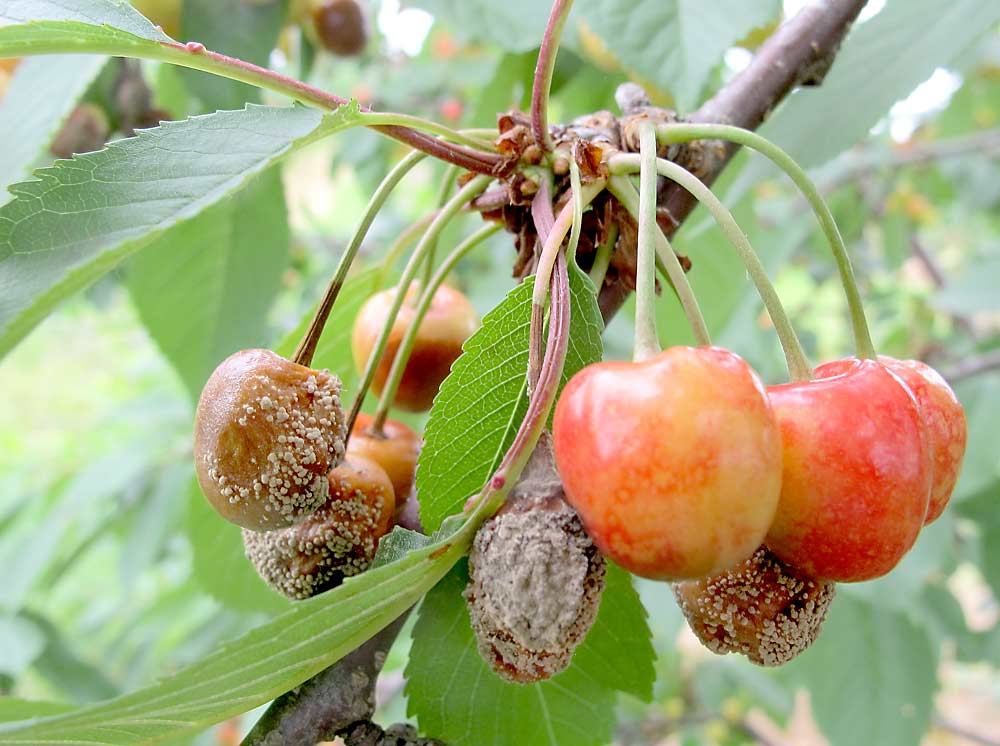
American brown rot hit Michigan sweet cherry orchards hard in 2019. The pathogen, Monilinia fructicola, is aggressive and grows quickly in warm and wet conditions, which makes it difficult to control even with access to good fungicides, said David Jones, an extension educator with Michigan State University.

And Michigan growers have fewer fungicide options now, because brown rot is showing strong resistance to Indar (fenbuconazole) across the state’s main growing regions, Jones said. A triazole or demethylation inhibitor (DMI) fungicide, Indar belongs to FRAC group 3.
As far as MSU plant pathologist George Sundin can determine, American brown rot’s resistance to Indar has gotten to the point where growers can’t realistically use the fungicide to control it anymore.
That’s unfortunate for Michigan stone fruit orchards, which have used Indar as a key management tool for brown rot for the last 30 years. Resistance to lower label rates (6 and 8 fluid ounces per acre) has been documented in the past, but for years growers still got good results from the maximum label rate (12 ounces). Tests conducted by Jones and Sundin in 2019, however, found widespread resistance to the maximum rate, a situation that effectively removes Indar as a management option.
Brown rot is a “huge issue” for sweet cherries (and somewhat less of an issue for tart cherries). It’s an issue for other stone fruit, too, including peaches and nectarines. The pathogen loves sugar and loves ripening cherries. Under the right conditions, infected fruits can produce “epidemic levels of inoculum” in 48 to 72 hours, with the potential to infect the entire orchard, according to Sundin.

Growers still have access to materials that combat American brown rot, including Flint Extra (strobilurin), a FRAC 11 fungicide, and Merivon or Luna Sensation, which are premixed FRAC 7 (SDHI) and 11 fungicides. Other tools include horticultural management practices, which should focus on minimizing humidity and moisture, probably the two biggest factors that favor the development of American brown rot, Jones said.
Management
The following recommendations, put together by Jones and Sundin, are based on the scientific community’s current understanding of the American brown rot pathogen’s life cycle and biology, Jones said.
Thin out shaded wood. Cutting out shaded limbs to open up the canopy will increase airflow and speed up drying of fruit following a rain, while decreasing humidity within the canopy. This also helps improve fungicide coverage.
Shorten large trees by a few feet in summer. This will help reduce the size and density of the canopy, leading to better airflow in the orchard. It also will improve spray coverage. In an older orchard, brown rot is almost always the worst at the tops of trees. July and August are good months to make those cuts, because the hot, dry weather will allow the wounds to scar over quickly, and temperatures are not conducive to bacterial canker.
Remove pendant wood. Rather than drying quickly, these limbs can stay damp for several hours after a rain event, providing an ideal environment for brown rot to develop. Encourage fruitful, lateral wood that will dry quickly after a rain event.
Consider shaking abandoned fruit onto the ground. Brown rot mummies in the canopy of a tree are a potent source of inoculum the following year and should be removed. Cutting mummies out during pruning, and flail chopping them in the row, also can reduce the inoculum load the following season.
Consider new plantings. Gisela rootstocks are good for training sweet cherries in a fruiting wall. This encourages thin canopies that dry quickly and get good airflow. These rootstocks are not a practical option for growers of processing sweet cherries but can work well for fresh-market growers. •
—by Matt Milkovich






Leave A Comment